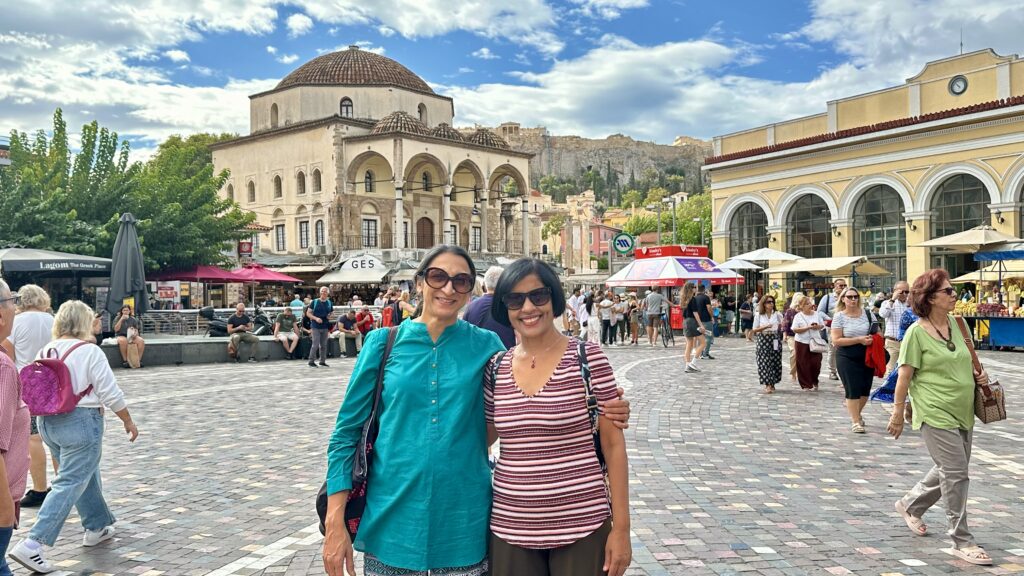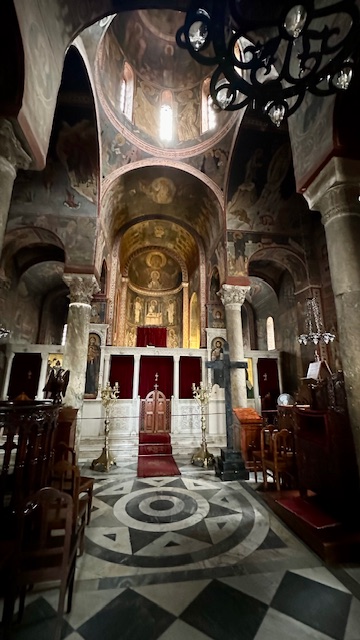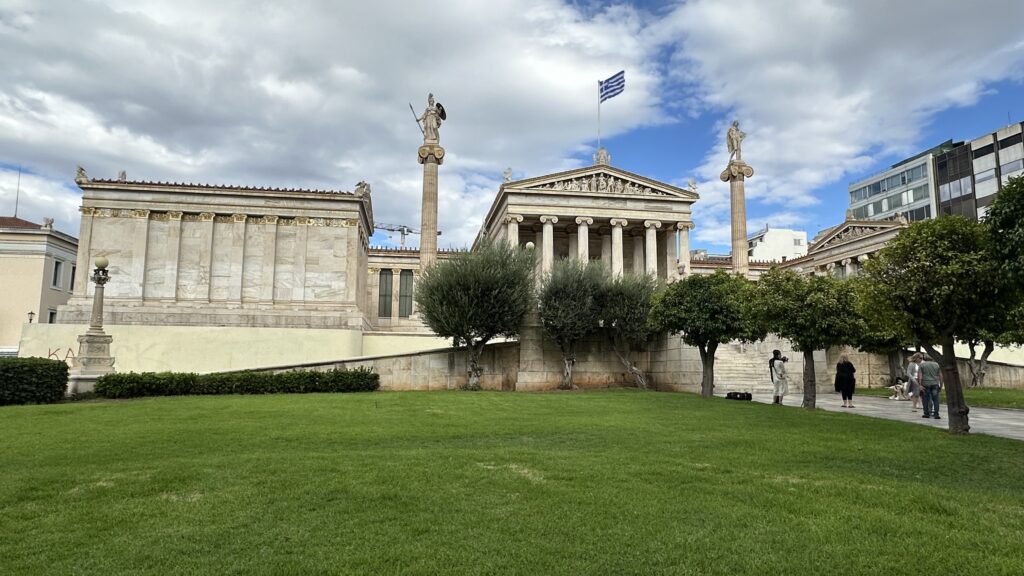3 Nights – Tiare by Mage Hotel
Day 1 – We landed in Athens at around 8:30am. The hotel which was a 30 min drive from the airport, had arranged for a van to pick us up. As the rooms were not ready, we left the luggage at the reception, freshened up, and took a walk down to our first attraction – Monastiraki Square, which was less than a mile from the hotel.
- Monastiraki Square
- Panaghia Kapnikaréa Church
- Church of Apostle Philippe
- Changing of Guard in Syntagma Square
- Zappeion Hall and garden
- Panathenaic Stadium
- National and Kapodistrian University of Athens
- Lycabettus Hill
- Mnisikleous Street stairs
Monastiraki Square – Located in the heart of Athens, Monastiraki is one of the city’s oldest neighborhoods, with the square being a famous meeting place for Athenians. From the middle of the square, you can see many roads leading in different directions. You can also get a good view of the Acropolis from here as well as the Tzistarakis Mosque which was built in 1759 and named after the Ottoman voivode of the city, Mustafa Aga Tzistarakis. The archaelogical sites of Ancient Agora, Roman Agora, Hadrian Library are all within walking distance from this square.

A road from the square leads to the the flea market! Clothes, shoes, jewelry, and everything else under the sun can be found here.



The Church of Panagia Kapnikarea – is located in the middle of the city’s most lively and crowded downtown street – Ermou Street, which connects Syntagma with Monastiraki Square. It is one of the oldest churches in Athens and one of the most significant Byzantine edifices. The church is dedicated to Panagia (The Virgin Mary). It was built in the early 11th century on the former location of an ancient temple that was dedicated either to the goddess Athena or the goddess Demeter, following the tradition of other early Christian churches.



Church of Apostle Philippe – This small church of St. Philippe is located in the old Athenian neighborhood of Vlassarous, opposite the entrance of the archaeological site of the Ancient Agora. We stopped by to take a quick peek inside.



Changing of Guard in Syntagma Square – This is the largest square in Athens and an important one as the parliament building is located here. There are often demonstrations on this square. The square was created in 1834 when King Otto had the new Royal Palace built. After several fires broke out in the palace, it was no longer suitable as a residence for kings. This palace was then designated as a parliament building after some restoration works. Excavations have shown that a cemetery used to be located on this square.

At the front of the building is the ‘Tomb of the Unknown Soldier‘, a monument built to honor anonymous soldiers who died fighting for the country. The Changing of the Guards takes place in front of the Tomb every hour daily. The Soldiers of the Presidential Guard stand in front of the Hellenic Parliament 24 hours a day, year-round. The guards wear traditional costumes, complete with pleated skirts, leg tassels, and pompom shoes.


National Garden – Located next to the Greek parliament, the National Garden is a large green, quite and shady place to relax and cool off. One can get a good hike walking the trails that lead through tall trees and it is all free to enjoy.


Zappeion Hall – This building is on the edge of the National garden. It was built in the 1870s and is generally used for meetings and ceremonies, both official and private and is one of the city’s most renowned modern landmarks. The Zappeion was used during the 1896 Summer Olympics as the main fencing hall. Inside the main entrance is an impressive round, open-air hall, lined by columns. On the day we visited, we had to pay 15€/person to see the inside of the hall.



Panathenaic Stadium – The stadium, built in a rectangular shape, was first used in 330 BCE to hold the Panathenaic games, likely as a rival to the Olympic Games held at Olympia. In the 2nd century CE, when Athens was under Roman rule, the Athenian writer Herodes Atticus funded the rebuilding of the stadium. This time it was built from marble, given a horseshoe shape, and enlarged to accommodate some 50,000 spectators. The structure that we see today is a replica of the original stadium, which was rebuilt for the Olympic Games of 1896. This modern-era Olympic Stadium was created in the identical fashion as the Panathenaic Stadium, with 47 tiers of seating and a rounded southeast end. The facility hosts concerts and other events during the summer.
Entry fee to the stadium was 15€/person. You can see most of the stadium from outside. We just checked it out from outside and were on our way.

National and Kapodistrian University of Athens – was officially founded on April 14th, 1837, and was the first University not only in Greece but both the Balkan peninsula and the Eastern Mediterranean region. It is currently the largest state institution of higher learning in Greece, and among the largest universities in Europe. It is within walking distance from Syntagma square, and one can spend a few minutes strolling around the university and admiring the buildings. The main building you see on the left in the below picture was once the only University building but now serves as a ceremony hall and rectory. As far as I know, it is not possible to take a tour of the university.


Lycabettus Hill – You can see this hill from many places around Athens. The view of Acropolis and the city from this hill is one of the best. At 227 meters in height, it’s the highest point in the city. You can either walk to the top or take a 3-min ride on the funicular that operates well into the night. We had already done a lot of walking that day and hence decided to take the funicular which was 12€/Person round trip. There is a church at the top that all are welcome to enter. Sunset from here should be amazing. When we went there around 5:30pm in September, the sun was beating down acropolis and the city below and we really could not get a good picture. Sunrise or after sunset/night time may be a good time to go there if you need to get some good pictures.



Location of the funicular – We took a taxi from our hotel to Aristippou St in Kolonaki. From here you can either walk up or take the funicular. If you are planning to walk, the path starts at the end of Aristippou Street and winds upwards(0.9mile) on Ploutarchou street and takes about 30 min. The funicular leaves from the corner of Ploutarhiou and Aristippou Streets every 30 minutes.
Mnisikleous Street stairs – This place is great if you are looking for some great dinner/lunch options. Restaurants line this set of stairs on the top end of Mnisikleous Street, and the atmosphere is lively and relaxed. In some of the restaurants. when the tables are full, people take to sitting on cushions on the stone stairs, and small knee-high wooden benches are brought out and placed on the stairs, creating an impromptu table. People are often tightly packed in, making for an intimate and friendly experience. The quality of food we had in the restaurant we selected was fairly good.



